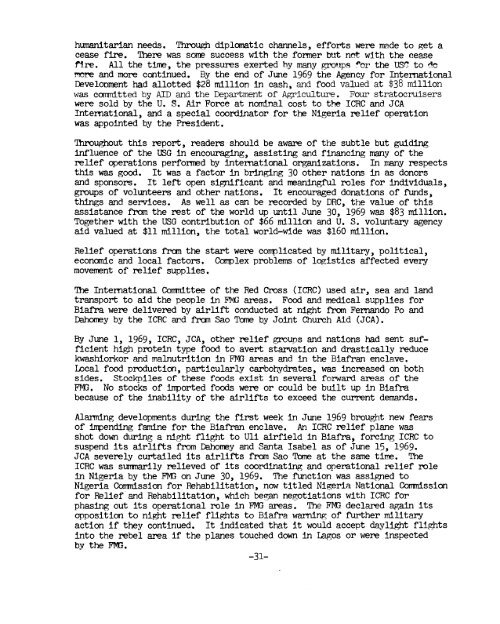3. - usaid
3. - usaid
3. - usaid
Create successful ePaper yourself
Turn your PDF publications into a flip-book with our unique Google optimized e-Paper software.
humanitarian needs. Throw diplomatic channels, efforts were made to get a<br />
cease fbe. There was some success with the former but not with the cease<br />
fire. All the time, the pressures exerted hy many p?~ps C%r the USC to 60<br />
mcre and more continued. By the end of June 1969 the Agency for International<br />
Develo~ment had allotted $28 million in cash, and food valued at $38 million<br />
was comdtted by AID and the Department of Apiculture. Four stratocmisers<br />
were sold by the U. S. Air Force at nominal cost to the ICRC and JCA<br />
International, and a special coordinator for the Nigeria relief operation<br />
was appointed by the Pllesident.<br />
Throwut this report, readers should be aware of the subtle but guiding<br />
influence of the USG in encouraging, assisting and financing many of the<br />
relief operations perfomd by internatimal organizations. In many respects<br />
this was good. It was a factor in bringing 30 other nations in as donors<br />
and sponsors. It left open significant and maningfhl roles for individuals,<br />
pups of volunteers and other nations. It encouraged donations of funds,<br />
things and services. As well as can be recorded by DRC, the value of this<br />
assistance from the rest of the world up until June 30, 1969 was $83 million.<br />
Together with the USG contribution of $66 million and U. S. voluntary agency<br />
aid valued at $11 million, the total world-wide was $160 million.<br />
Relief operations f'ran the start were corrplicated by military, political,<br />
economic and local factors. Complex problems of lcgistics affected every<br />
movement of relief supplies.<br />
The International Camnittee of the Red Cross (ICRC) used air, sea and land<br />
transport to aid the people in FPK; areas. Food and medical supplies for<br />
Biafra were delivered by airlift conducted at night f'run Fernando Po and<br />
Dahmy by the ICRC md frcm Sao Tome by Joint Church Aid (JCA).<br />
By June 1, 1969, ICRC, JCA, other relief pups and nations had sent sufficient<br />
high pmtein type food to avert starvation and drastically reduce<br />
kwashiorkor and malnutrition in FMG areas and in the Biafran enclave.<br />
hcal food production, particularly carbohydrates, was increased on both<br />
sides. Stockpiles of these foods exist in several forward amas of the<br />
FMG. No stocks of imported foods were or could be built up in Biafra<br />
because of the inability of the airlifts to exceed the current demands.<br />
Alarming developments during the first week in June 1969 brought new fears<br />
of mending famine for the Biafran enclave. An ICRC relief plane was<br />
shot down during a nipJt flight to Uli airfield in Biafra, forcing ICRC to<br />
suspend its airlifts from Dahomy and Santa Isabel as of June 15, 1969.<br />
JCA severely curtailed its airlifts fm Sao Tome at the same time. The<br />
ICRC was sunsnarily relieved of its coordinating and opemtional relief mle<br />
in Nigeria by the FE on June 30, 1969. The function was assigned to<br />
Nigeria Comnisslon for Rehabilitation, now titled Nigeria National Comnissim<br />
for Relief and Rehabilitation, which be- negotiations with ICRC for<br />
phasing out its operational role in FTG mas. The FMG declared again its<br />
opposition to night relief flights to Biafra warninp; of further military<br />
action if they continued. It indicated that it would accept daylight flights<br />
into the rebel area if the planes touched down in Lagos or were Inspected<br />
by the FPE.<br />
-31-
















